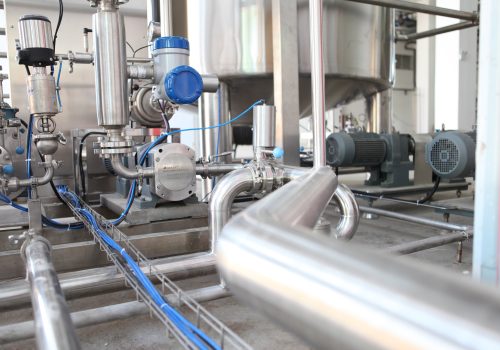What to make of China’s latest restrictions on critical mineral exports
On October 20, Beijing announced new export restrictions on graphite, following similar restrictions placed on gallium and germanium exports earlier this summer. Together, these announcements have been met with alarm given the dominant role China plays in the production of these minerals, as well as the minerals’ important role in the semiconductor industry and the clean energy economy. Graphite is an important component in electric vehicle batteries and nuclear reactors, while gallium and germanium are used to produce semiconductors.
Decisions such as this announcement clarify the risks of China’s significant role in mineral and metal supply chains. Export allowances by permit (which, for now, are how these restrictions appear to be functioning) not only introduce further opacity into markets, but also allow Beijing to boost national champions or disadvantage companies that are too aligned with “unfriendly” countries, potentially creating a prolonged risk of disruption for the West.
Yet, as China begins to use its “resource leverage,” several contextual notes should help inform strategists, investors, and policymakers alike about how these risks may unfold further.
Most importantly, these new export restrictions come as a response to the United States tightening artificial intelligence–related export restrictions. China’s export restrictions on gallium and germanium this summer followed announcements from the United States, European Union (EU), and Netherlands to restrict certain advanced semiconductor sales to China. Beijing’s October 20 announcement adding graphite to those restrictions followed the United States updating its rules to expand restrictions on the export of high-performance semiconductors to China. This reflects a tit-for-tat dynamic that has characterized other aspects of the China-US relationship, one likely spurred by Beijing’s interest in not appearing to be pushed around by Washington, and more broadly demonstrating its relevance to the high-tech clean energy economy.
A ladder of escalating trade tensions appears to be emerging, with Western high-tech restrictions on one side and Chinese resource restrictions on the other.
Adding to this tit-for-tat dynamic is that it’s hard to characterize China’s export restrictions as aggressive enough to yield concessions or relief from the United States for the tightening of artificial intelligence and semiconductor supply chains. One month into the enforcement of export controls for gallium and germanium, shortages have yet to permeate downstream markets (though this is possibly due to stockpiling initially following the announcement), and China appears so far to be issuing permits without disruption two months after the launch of the permitting regime. China’s addition of graphite to its export restrictions occurs at a time when available pricing data indicate that markets are relatively well supplied, while a window before the permit regime begins in December also offers an opportunity for stockpiling. While Beijing has effectively demonstrated its capacity to interfere in the supply chain, this demonstration has yet to be translated in a manner designed to bring the United States or Europe to the negotiating table.
This reflects some of the strategic limitations to Beijing aggressively intervening in mineral supply chains. Indeed, the lack of off-the-shelf alternatives in most mineral supply chains in which China enjoys significant market share means that aggressive tightening of export restrictions would be highly disruptive to the West in the short term. However, for graphite, germanium, and gallium, the severity of such disruption is much more uncertain. Germanium and gallium are most frequently found alongside other, more commonly mined and produced materials such as bauxite, zinc, coal, and alumina. Graphite, meanwhile, has relatively diverse upstream resources from which to source alternatives.
As a result, should export controls tighten too strongly or too quickly, the use of these alternatives will increase dramatically when—all things being equal—they would otherwise not have been economic to bring online. China’s 2010 embargo of Rare Earth Element (REE) exports to Japan reflects this dynamic—the embargo made alternatives more economically feasible while being enough of a shock to catalyze political support to invest in those alternatives. This ultimately resulted in the establishment of the region’s first non-Chinese REE processing facility in Malaysia.
For now, the introduction of these restrictions should be interpreted more as a necessary political measure for China’s credibility, and/or Beijing testing the extent to which it can use its resource leverage without overplaying its hand, rather than an attempt to force concessions or negotiations. The export controls establish a platform China could build on, but the circumstances for that action require significantly more elevated conditions in China’s relationship with the West.
This does not mean, however, that Western policymakers should ignore the escalating nature of Beijing’s response. Unlike germanium or gallium, the inclusion of restrictions on a higher-value goods such as spherical graphite—a precursor for the anodes in electric vehicle batteries—now includes both upstream resources and the intellectual property associated with refining that good to China’s leverage. Alternative sources of graphite are available, but certain refined or precursor products that use graphite will rely on more than just market forces to bring replacement supplies online in a timely and effective manner.
A ladder of escalating trade tensions appears to be emerging, with Western high-tech restrictions on one side and Chinese resource restrictions on the other. The extent to which acknowledgement of this paradigm is cross-pollinating between emerging US and EU industrial policymaking and national security efforts around artificial intelligence and microchips is therefore an important space to watch. For example, growing concerns about the rate of Chinese electric vehicle imports into Europe are adding tailwinds in Brussels to policies aimed at protecting European automakers, which could mean another turn in this tit-for-tat quarrel is on the horizon.
Marginal increases in the potential severity of supply chain disruption will remain Beijing’s most likely response, so long as it remains mindful to not overplay the leverage it has built in mineral supply chains over several decades. Nonetheless, China remains in a position to use that leverage with an eye to securing concessions from the United States and EU, should it so choose. Washington and Brussels continue to work through longer-term safeguards, such as a long-awaited critical minerals agreement, as a hedge against more severe forms of disruption. But more active US-EU collaboration to identify and manage the possibility of escalation is needed, especially as tensions around trade and national security persist on both sides of the Atlantic.
Reed Blakemore is the director of research and programs at the Atlantic Council Global Energy Center.
Further reading
Fri, Sep 15, 2023
Planning around strategic supply chains will require more than just ‘listing’ of critical minerals
Testimony By Reed Blakemore
We need to ensure that our minerals policy does not become overly clerkish, prescribing problems rather than solving them. Capturing the supply/demand dynamism between each critical mineral will illuminate the pathways to build a cohesive minerals strategy.
Thu, Sep 21, 2023
The United States’ edge in the clean energy economy starts with outcompeting China on hydrogen
EnergySource By Landon Derentz
The Biden administration’s momentum on bolstering the United States’ significance in the global green economy must start with an inclusive approach to hydrogen tax credits.
Tue, Oct 24, 2023
Why COP28 is right to prioritize global methane and flaring reduction
Issue Brief By
Flaring and methane emissions from oil and gas are a substantial source of greenhouse gas emissions globally, but the funding, technology, and business practices are available to bring these emissions to near-zero. The COP28 platform can accelerate these solutions.
Image: HANGZHOU, CHINA - MAY 30, 2023 - A 2-inch (50.8 mm) diameter gallium oxide wafer is pictured at the Hangzhou International Science and Innovation Center of Zhejiang University in Hangzhou, Zhejiang province, China, May 30, 2022. On the evening of July 3, 2023, the Ministry of Commerce and the General Administration of Customs issued the Announcement on the Implementation of Export Control of Gallium and germanium Related Items. (Photo by Costfoto/NurPhoto)


